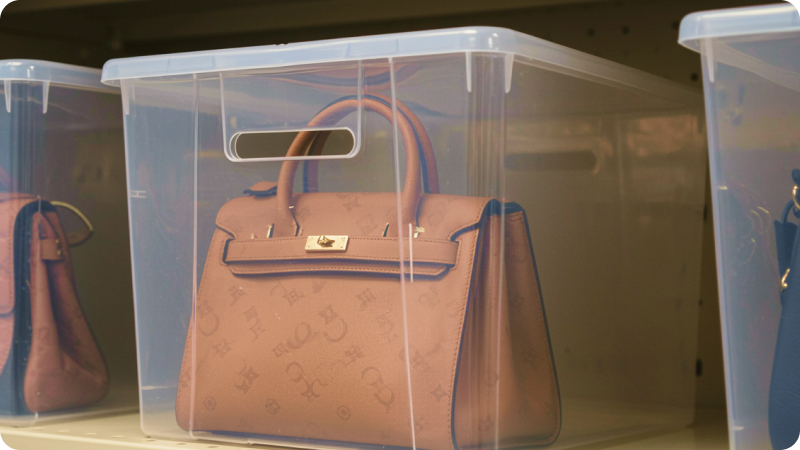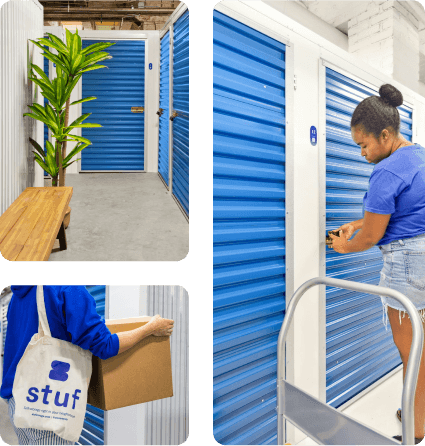Summer is calling, and you’re ready to disappear for a week, a month, maybe more. But while you're mapping out hikes in Yosemite or beach days in Tulum, what’s happening back home?
Most travelers don’t think twice about what they’re leaving behind until something goes wrong. A power outage that ruins electronics, a break-in while your place sits empty, or a last-minute subletter who’s not as “respectful” as promised.
This is where self-storage units earn their place in your pre-vacation checklist. They’re there to keep the things you care about secure, climate-protected, and out of harm’s way while you’re off living life
In this guide, we’ll show you exactly what to store before your summer getaway, how to do it smartly, and the surprisingly common mistakes that can turn a relaxing trip into a stressful return.
Why You Need to Store Your Items in Safe and Secure Self Storage Units When Travelling
Summer is the busiest travel season in the U.S., with millions of Americans hitting the road, boarding flights, or relocating temporarily for seasonal work, school breaks, or family obligations. In fact, according to the U.S. Travel Association, summer consistently accounts for nearly 30% of annual domestic leisure travel, and that number continues to grow each year.
But this seasonal mobility brings unique logistical challenges and risk that many travelers may underestimate.
Common scenarios that justify summer storage
-
Subletting your home or apartment while traveling.
-
Listing your space on Airbnb and needing to remove personal items.
-
Studying abroad or taking part in summer internships across state lines.
-
College students moving out between semesters.
- Extended family travel with no one at home for weeks.
In all of these situations, affordable secure self-storage can help protect items you don’t want damaged, lost, or misused while giving you the flexibility to travel without stress. And with the increasing availability of climate-controlled storage, you can also shield sensitive belongings from the extreme heat and humidity that define the summer months in much of the U.S.

What to Store Before You Leave: A Smart Summer Storage Checklist
Not everything in your home needs to be stored while you're away, but some things absolutely should be. Below is a curated checklist designed for real-world summer travelers.
1. Climate-sensitive items
Extreme summer temperatures, especially in states like Texas, Arizona, or Florida, can
warp, melt, or degrade materials faster than you think. And that is not something you’d want to come home to after a great summer vacation.
What to store:
-
Electronics & Drives: Back them up and pack in their original boxes withanti-static bags and silica gel packs to shield from moisture. Also, don’t forget to take their batteries outto prevent potential damage from battery leaks or corrosion
-
Musical Instruments & Artwork: Storing these would keep wood from warping and paper from yellowing.
-
Cosmetics and skincare: Keeping them in safe, climate-controlled spaces will help avoid heat separation and spoilage
I recommend storing these items in a climate-controlled unit like what Stuf Storage offers in many of their locations. These units maintain a steady 60–80°F and 30–50% humidity, which is the gold standard for storage.
2. Designer watches and jewelry
These are prime burglary targets. In fact, June, July, and August see the highest number of residential burglaries with June accounting for 11.3% of cases.
What to store:
-
Diamond rings, earrings, necklaces.
-
Rolex, Omega, or Tag Heuer watches.
-
Family heirlooms or antique pieces.
According to security experts, most burglars head straight to bedroom drawers and closets, making home safes far less secure than we think. A safe and secure self storage unit with video surveillance, PIN-only access, and individual alarms is far safer for valuables.
3. Designer handbags and high-end fashion accessories
If you’re subletting or leaving your space accessible to others, luxury goods are at risk of wear, theft, or idity damage. But when storing these items, you have to be very careful.
Vogue-endorsed fashion archivists at Garde Robe advise stuffing luxury bags with acid-free tissue paper and storing them in breathable muslin garment bags, not plastic, to prevent mold and preserve shape.
What to store:
-
Leather handbags (e.g. Louis Vuitton, Hermès)
-
Designer shoes or archival fashion pieces
-
Fur coats or garments sensitive to temperature shifts
4. Rare collectibles and memorabilia
Collectors know that graded cards, autographs, coins, and rare books need stable climate conditions and protection from light. Experts advise flat stacking in rigid protective sleeves under moderate climate, away from humidity and light.
What to store:
-
Graded trading cards (e.g. PSA-graded Pokémon or sports cards)
-
Comic books, figurines, autographed memorabilia
-
Coin collections or stamp albums
5. Fine art and framed photography
Artwork is particularly sensitive to heat and moisture, which can cause warping, fading, or fungal growth. Conservators recommend vertical storage with acid-free packing in climate-controlled settings to prevent damage
6. Important paper and archival documents
Important papers and legacy materials are not only at risk of theft, but also from warping and yellowing in humid summer conditions. When storing these, use hard-shell,waterproof containers. Also, its best to use acid-free folders and even archival sleeves.
What to store:
-
Academic portfolios or research archives
-
Signed manuscripts or rare books
7. Data drives and digital backups
Data loss is common during summer blackouts or heatwaves, especially if drives are left in drawers or cabinets at home. Tech professionals recommend redundant, offsite storage in padded, climate-controlled environments. To ensure their complete safety, use anti-static, padded cases.
-png.png?width=1015&height=571&name=Frame%20116%20(1)-png.png)
What Should You Not Store in a Storage Unit During Summer?
While affordable self storage units, especially climate-controlled ones, are ideal for protecting many of your belongings during travel, there are some things that are either prohibited by law, unsafe in heat, or simply unsuitable for storage conditions.
Here’s a breakdown of what you should avoid storing over the summer months:
1. Perishable food and plants
Even in climate-controlled storage, perishable items like fruits, vegetables, or anything that requires refrigeration can spoil quickly, attract pests, and cause mold or odors.
According to research, improperly stored organic matter can also release harmful ,bacteria and mycotoxins. It can even become the source of mold in your otherwise pristine storage unit.
Before leaving, consume the food or give it away. As for plants, see if you can have someone drop by your home at least once a week to water them. I also recommend moving them to a cooler area to reduce their watering needs.
2. Flammable or hazardous materials
Storage providers strictly prohibit these items due to their potential for combustion, especially in hot weather. This includes items like gasoline, paint thinners, propane tanks, fireworks, and cleaning chemicals
So store these in cool and dry spaces at home, such as under the sink or in a cool cupboard. If you don’t have a safe space for these at home, consider safely disposing of them before leaving on a long summer vacation
3. Medications and temperature-sensitive health products
Some medications can be stored at room temperature, however, there are temperature-sensitive drugs that need to be stored within a certain temperature range to prevent losing their potency. Most of these need to stored between 59°F and 77°F (15°C and 25°C)
To prevent wasting these medications, leave them with a trusted family member or arrange for pharmacy pickup on your return.
4. Pets and animals
It should go without saying, but unfortunately, some renters try to temporarily house animals or exotic pets in storage. This is both illegal and inhumane.
Better arrange for a pet sitter, friend, or boarding service.
5. Old film, vinyl records, and magnetic tapes
Analog media is especially fragile in high humidity or heat. Film can melt, vinyl can warp, and cassette tapes can demagnetize, making memories and collections permanently damaged.
I recommend storing these in proper wrappings in climate-controlled storage units. If that’s not an option, it would be better to digitize and store copies in your self-storage units.
Can I Access My Self-Storage Unit While on Vacation?
Yes but depends entirely on the storage provider you choose. Here’s what you need to know:
Remote and app-based access :
Modern storage providers like Stuf Storage offer app-based, keyless access, allowing you to:
- Share digital access with trusted friends, family, or assistants
- Track access history while you're away
So, no matter where you are in the world, your self-storage unit remains highly accessible to the people you trust and authorize for anything you or they might need to get.
Add an authorized contact before you leave
If your storage provider doesn't offer digital access, set up an authorized user in advance. Be sure to provide their name and contact info to the storage manager, and leave a spare key (or access code) with them. This is someone who can:
- Access the unit in emergencies
- Retrieve or deposit items you may unexpectedly need
- Handle paperwork or insurance claims if issues arise
Be aware of access hours and holiday schedules
Many facilities operate on standard business hours, even during summer holidays. If you think you’ll need to get something out of storage on short notice, consider:
- Choosing a facility with extended or 24/7 access
- Verifying holiday hours in advance (e.g., 4th of July closures)
- Planning retrievals before your trip starts
How to Reintegrate Stored Items Back Into Your Space
Returning from a long summer getaway brings the welcome comfort of home, but also the inevitable question: What now?
After weeks or months away, reintegrating your belongings from self storage can feel overwhelming if you haven’t planned for it. But here are some tips to do it right:
Tip #1: Start only with what you need, not everything at once
It’s tempting to retrieve everything from your unit in one go, but this approach can easily turn your post-holiday calm into cluttered chaos. Instead, prioritize essentials:
- Items you’ll use immediately, such as work laptops, documents, or everyday clothing
- Personal effects like chargers or kitchen items you stored for safekeeping
- Gear that may require cleaning, repair, or reassembly (e.g., bicycles, electronics)
Tip #2: Inspect everything before you bring them back indoors
Even if you used a climate-controlled, safe and secure self storage unit, it’s wise to examine each item thoroughly before returning it to your home. Dust, shifts in humidity, or unnoticed damage can occur over time. Prioritize the following checks:
- Look for moisture exposure on documents or leather goods
- Test electronics before plugging them in to prevent power surges or damage
- Air out textiles, linens, and clothes, even if bagged, before returning them to closets
Tip #3: Use reintroduction as a mini declutter session
Decluttering may be the last thing on your mind after a great vacation but taking things out of storage is actually an ideal time to reassess your possessions. Some items might have lost their relevance while you were away. Use the reintegration process as an opportunity to:
- Donate items that didn’t get used last season
- Toss anything that’s damaged or expired (especially toiletries or pantry backups)
- Reconsider whether certain gear (like beach inflatables or camping gear) could remain in storage year-round
Stress Less, Travel Smarter: Let Self Storage Simplify Your Summer
A well-planned storage strategy can mean the difference between a chaotic departure and a calm, carefree summer. By securing valuables, decluttering your space, and using a reliable self storage provider, you’re not just protecting your belongings, you’re giving yourself the freedom to enjoy your trip without what-if worries.
If you’re after a smarter, more flexible option, providers like Stuf Storage make it easy. With climate-controlled units, app-based access, and secure, affordable facilities in key U.S. cities, they’re well-suited for summer travelers looking to simplify before they go.
.png?width=1038&height=318&name=Frame%20113%20(1).png)








